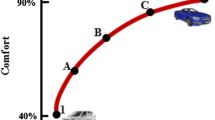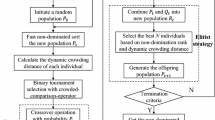Abstract
Sustainable product service system (S-PSS) regarded as an evolution of existing product development approaches which incorporates services as well as products for achieving sustainable development. Therefore, several IT manufacturers around the world have developed plans for fulfilling consumer’s needs by providing a combination of product and services and also management of product at the end of its life (EOL). Hence, it is essential to develop an analytical model that can help manufacturers to analyze their S-PSS plans. We model both optimization of environmental and economical impacts of the product during consumption and end of life phase from point of view of the consumer and manufacturer. A multi-objective genetic algorithm has been applied to simultaneously optimize service period and product EOL decisions. Finally, a case study of a notebook market is provided to show the applications of the model.
Similar content being viewed by others
References
Ahluwalia P. K., Nema A. K. (2007) A life cycle based multi-objective optimization model for the management of computer waste. Resources, Conservation and Recycling 51: 792–826
Baines, T. S., et al. (2007). State-of-the-art in product-service systems. Proceedings of the Institution of Mechanical Engineers, Part B: Journal of Engineering Manufacture, 221, 1543–1552.
Blischke W. R., Murthy D. N. P. (1996) Product warranty handbook. Marcel Dekker, New York
Cerinšek, G., Petersen, S. A., & Heikura, T. (2011). Contextually enriched competence model in the field of sustainable manufacturing for simulation style technology enhanced learning environments. Journal of Intelligent Manufacturing. doi:10.1007/s10845-011-0554-0.
Chien Y. H. (2005) Determining optimal warranty periods from the seller’s perspective and optimal out-of-warranty replacement age from the buyer’s perspective. International Journal of Systems Science 36: 631–637
Cooper, T., & Mayers, K. (2000). Prospects for household appliances. E-SCOPE survey. Centre for Sustainable Consumption, Sheffield Hallam University.
Deb K., Pratab A., Agarwal S., Meyarivan T. (2002) A fast and elitist multiobjective genetic algorithm: NSGA-II. IEEE Transactions on Evolutionary Computation 6: 182–197
Dehghanian F., Mansour S. (2009) Designing sustainable recovery network of end-of-life products using genetic algorithm. Resources, Conservation and Recycling 53: 559–570
Dell. (2012). http://content.dell.com/us/en/corp/brand-sustainability. Accessed 1 July 2012.
Gao J., Yao Y., Zhu C. Y., Sun L., Lin L. (2011) Service-oriented manufacturing: A new product pattern and manufacturing paradigm. Journal of Intelligent Manufacturing 22: 435–446
Giudice F., Fargione G. (2007) Disassembly planning of mechanical systems for service and recovery: A genetic algorithms based approach. Journal of Intelligent Manufacturing 18: 313–329
Halme M., Anttonen M., Hrauda G., Kortman J. (2006) Sustainability evaluation of European household services. Journal of Cleaner Production 14: 1529–1540
Hanafiah, L. Y., Chen, H., & Narita, H. F. (2003). Remanufacturing in developing countries concentrated at leasing or selling—A case study of Indonesia. In Proceedings of EmDesbn2003 in third international symposium on environmentally conscious design and inverse manufacturing (pp. 8–11), Tokyo.
IBM. (2012). http://ibm.com/ibm/environment. Accessed 1 July 2012.
Iranrahjoo. (2012). Warranty provider for Sony notebook. http://www.iranrahjoo.com. Accessed 1 July 2012.
IRICA. (2012). http://www.irica.gov.ir/Portal/Home/. Accessed 1 July 2012.
Itiran. (2012). Iran information technology data. http://www.itiran.com/?type=article&id=13822. Accessed 1 July 2012.
Jönbrink, A. K., Wolf-Wats, C., Erixon, M,. Olsson, P., & Wallén, E. (2000). LCA software survey. IVL report No B1390. Stockholm: IVL Swedish Environmental Research Institute Ltd.
Jun H. B., Cusin M., Kiritsis D., Xirouchakis P. (2007) A multi-objective evolutionary algorithm for EOL product recovery optimization: Turbocharger case study. International Journal of Production Research 45: 4573–4594
Jung K. S., Hwang H. (2011) Competition and cooperation in a remanufacturing system with take-back requirement. Journal of Intelligent Manufacturing 22: 427–433
Kameshwaran S., Viswanadham N., Desai V. (2009) Bundling and pricing of product with after sales services. International Journal of Operational Research 6: 92–109
Kimura, F. (2000). A methodology for design and management of product life cycle adapted to product usage modes. CIRP International Seminar on Manufacturing Systems, Stockholm, 139–142.
Kimura, F., Hata, T., & Suzuki, H. (1998). Product quality evaluation based on behavior simulation of used products. Annals of CIRP, Tokyo, 47, 119–122.
Kuo T. C. (2011) Simulation of purchase or rental decision-making based on product service system. International Journal of Advanced Manufacturing Technology 52: 1239–1249
Leitão, P., Mendes, J. M., Bepperling, A., Cachapa, D., Colombo, A. W., & Restivo, F. (2011). Integration of virtual and real environments for engineering service-oriented manufacturing systems. Journal of Intelligent Manufacturing. doi:10.1007/s10845-011-0591-8.
Louis, Y. L., & Chiang, C. (2008). Prediction model for warranty costs: A case study of a LCD monitor company. IEEE Asia-Pacific Services Computing Conference, 1418–1423.
Mangun D. C., Thurston D. L. (2002) Incorporating component reuse, remanufacture, and recycle into product portfolio design. IEEE Transactions on Engineering Management 49: 479–490
Maxwell D., VanderVorst R. (2003) Developing sustainable products and services. Journal of Cleaner Production 11: 883–895
Michelini R. C, Razzoli R. P. (2004) Product-service for environmental safeguard: A metrics to sustainability. Resources, Conservation and Recycling 42: 83–98
Ness, D., & Wagner, M. H. (2007). Sustainable product service systems: Potential to deliver business and social benefits with less resource use, greening the business and making environment a business opportunity (pp. 1–17), Bangkok, Thailand.
Nnorom I. C., Osibanjo O. (2008) Overview of electronic waste (e-waste) management practices and legislations, and their poor applications in the developing countries. Resources, Conservation and Recycling 52: 843–858
Roy R. (2000) Sustainable product-service systems. Futures 32: 289–299
Sandborn, P., & Myers, J. (2008). Designing engineering systems for sustainability. In K. B. Misra (Ed.), Handbook of performability engineering (pp. 81–103). London: Springer.
SIMAPRO. (2012). Software for environmental assessment. http://www.pre.nl/simapro. Accessed 1 July 2012.
Sony. (2012). http://www.sony.net/SonyInfo/csr/innovation/index.html. Accessed 1 July 2012.
Stahel, W., & Reday, G. (1976). Jobs for tomorrow: The potential for substituting manpower for energy. Brussels: Vantage Press.
Subramanian, R., Guptay, S., & Talbot, B. (2011). Remanufacturable product design and contracts under extended producer responsibility, working paper. http://www.eclips.gatech.edu/files/articles/eclips_remanufacturable.pdf. Accessed 1 July 2012.
Thurston D. L., Delatorre J. P. (2007) Leasing and extended producer responsibility for personal computer component reuse. International Journal Environment and Pollution 29: 104–126
Toshiba. (2012). http://tapl.asia.toshiba.com/csr/index.php?option=com_content&view=article&id=113&Itemid=176. Accessed 1 July 2012.
Tukker A. (2004) Eight types of product–service system: Eight ways to sustainability? Experiences from SusProNet. Business Strategy and the Environment 13: 246–260
Warranty week. (2012). http://www.warrantyweek.com/archive/ww20080521.html. Accessed 1 July 2012.
Watanabe, K., Mikoshiba, S., Tateyama, T., & Shimomura, Y. (2011). Service process simulation for integrated service evaluation. Journal of Intelligent Manufacturing. doi:10.1007/s10845-010-0497-x.
Wu C. C., Chou C. Y., Huang C. (2009) Optimal price warranty length and production rate for free replacement policy in the static demand market. Omega 37: 29–39
Xanthopoulos A., Iakovou E. (2009) On the optimal design of the disassembly and recovery processes. Waste Management 29: 1702–1711
Yu, S., Kato, S., & Kimura, F. (2001). Eco-design for product variety: A multi-objective optimization framework. In 2nd International symposium on environmentally conscious design and inverse manufacturing (pp. 293–298), Tokyo.
Zhao Y., Pandey V., Kim H., Thurston D. (2010) Varying lifecycle lengths within a product take-back Portfolio. Journal of Mechanical Design 132: 1–10
Author information
Authors and Affiliations
Corresponding author
Rights and permissions
About this article
Cite this article
Shokohyar, S., Mansour, S. & Karimi, B. A model for integrating services and product EOL management in sustainable product service system (S-PSS). J Intell Manuf 25, 427–440 (2014). https://doi.org/10.1007/s10845-012-0694-x
Received:
Accepted:
Published:
Issue Date:
DOI: https://doi.org/10.1007/s10845-012-0694-x




